You deploy an SAP environment on Azure.
You need to grant an SAP administrator read-only access to the Azure subscription. The SAP administrator must be prevented from viewing network information.
How should you configure the role-based access control (RBAC) role definition? To answer, drag the appropriate values to the correct targets. Each value may be used once, more than once, or not at all. You may need to drag the split bar between panes or scroll to view content.
NOTE: Each correct selection is worth one point.
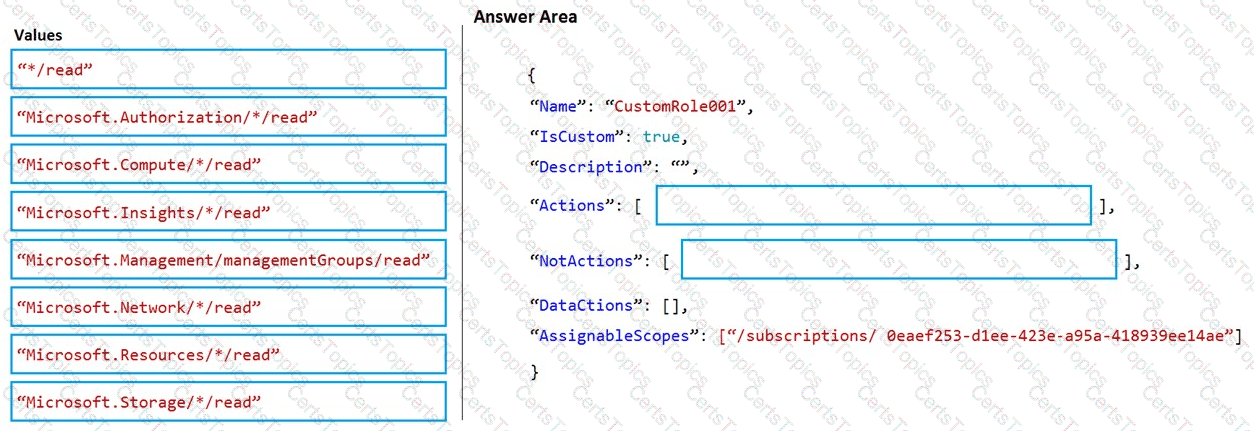
For each of the following statements, select Yes if the statement is true. Otherwise, select No.
NOTE Each correct selection is worth one point.

You are planning the deployment of a three-tier SAP landscape on Azure that will use SAP HANA. The solution must meet the following requirements:
Network latency between SAP NetWeaver and HANA must be minimized.
An SAP production landscape on Azure must be supported.
Network performance must be validated regularly.
What should you include in the solution? To answer, select the appropriate options in the answer area.
NOTE: Each correct selection is worth one point.
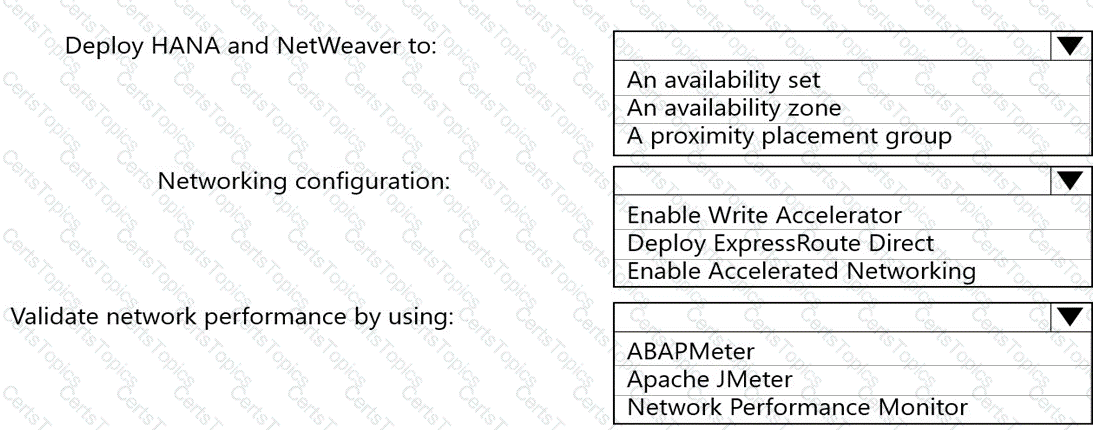
This question requires that you evaluate the underlined BOLD text to determine if it is correct.
You have an Azure resource group that contains the virtual machines for an SAP environment.
You must be assigned the Contributor role to grant permissions to the resource group.
Instructions: Review the underlined text. If it makes the statement correct, select “No change is needed”. If the
statement is incorrect, select the answer choice that makes the statement correct.
You have an on-premises SAP NetWeaver landscape that contains an IBM DB2 database.
You need to migrate the database to a Microsoft SQL Server instance on an Azure virtual machine.
Which tool should you use?
You ate planning an SAP on Azure deployment.
You need to recommend a storage access solution that meets the following requirements;
• Provides a common file share that will be accessed by virtual machines that run either Red Hat Enterprise Linux (RHEL) or Windows Server 2022.
• Ensures that each virtual machine uses its native sharing protocol to access the common file share.
Which type of storage should you include in the recommendation?
You migrate an on-premises instance of SAP NANA that runs SUSE Linux Enterprise Server (SLES) to an Azure virtual machine.
You project that in two years, you will replace the virtual machine with a larger virtual machine within the same flexibility group.
You need to recommend solutions to minimize HANA deployment costs during the next three years. The solutions must not affect the availability SLAs.
Which two solutions should you recommend? Each correct answer presents a complete solution
NOTE: Each correct selection is worth one point.
Your company has a an on-premises SAP environment.
Recently, the company split into two companies named Litware, inc and Contoso.Ltd. Litware retained the SAP environment.
Litware plans to export data that is relevant only to Contoso. The export will be 1.5 TB.
Contoso build a new SAP environment on Azure.
You need to recommend a solution for Litware to make the data available to Contoso in Azure. The solution must meet the following requirements:
Minimize the impact on the network.
Minimize the administrative effort for Litware.
What should you include in the recommendation?
Your on-premises network contains an Active Directory Domain Services (AD DS) domain that syncs with a Microsoft Entra tenant by using Microsoft Entra Connect.
You plan to deploy an on-premises instance of SAP NetWeaver that will integrate with SAP Cloud Identity Services.
You need to configure an authentication solution for the deployment The solution must meet the following requirements:
• Ensure that users can authenticate to NetWeaver and SAP Cloud Identity Services by using their AD DS domain credentials.
• Enforce multi-factor authentication (MFA).
• Minimize administrative efforts.
What should you include in the solution? To answer, drag the appropriate components to the correct platforms. Each component may be used once, more than once, or not at all. You may need to drag the split bar between panes or scroll to view content.
NOTE: Each correct selection is worth one point.

You plan to migrate an on-premises SAP development system to Azure.
Before the migration, you need to check the usage of the source system hardware, such as CPU, memory, network, etc.
Which transaction should you run from SAP GUI?
You have an on-premises network and an Azure subscription.
You plan to deploy a standard three-tier SAP architecture to a new Azure virtual network.
You need to configure network isolation for the virtual network. The solution must meet the following requirements:
• Allow client access from the on-premises network to the presentation servers.
• Only allow the application servers to communicate with the database servers.
• Only allow the presentation servers to access the application servers.
• Block all other inbound traffic.
What is the minimum number of network security groups (NSGs) and subnets required? To answer, drag the appropriate number to the correct targets. Each number may be used once, more than once, or not at all. You may need to drag the split bar between panes or scroll to view content.
NOTE Each correct selection is worth one point.

You have an Azure subscription.
You plan to deploy an SAP landscape by using Azure Center for SAP solutions.
You need to use custom virtual machine images for the deployment.
To what should you set Security type for the virtual machines, and where should you store the custom images? To answer, select the appropriate options in the answer area,
NOTE: Each correct selection is worth one point.

You deploy an SAP production landscape on Azure virtual machines that run SUSE Linux Enterprise Server (SLES).
You need to generate a report that details performance differences between instances of an SAP AS ABAP system.
What should you use?
You plan to deploy SAP HANA to an Azure virtual machine that has a constrained vCPU size.
You need to validate that the virtual machine complies with SAP-defined resource requirements by using the SAP HANA Hardware and Cloud Measurement Tools (HCMT).
In which order should you perform the actions? To answer, move all actions from the list of actions to the answer area and arrange them in the correct order.

You have an SAP on Azure landscape. You need to gather the following metrics:
• The network latency between an SAP NetWeaver server and an SAP HANA server.
• The throughput and latency of the storage subsystem on Windows Server and Linux platforms
What should you use for each metric? To answer, select the appropriate options in the answer area. NOTE: Each correct selection is worth one point.

You have an SAP on Azure landscape.
You configure SAP Central Services (SCS) to write logs to Windows Event Viewer.
You need to collect the logs in Azure Monitor by using a Data Collection Rule (DCR). The solution must prevent the logs from being sent via the internet.
Which two resources should you configure? Each correct answer presents part of the solution.
NOTE: Each correct selection is worth one point.
You have an SAP NetWeaver deployment hosted on Azure virtual machines that run SUSE Linux Enterprise Server (SLES) and are configured as a Pacemaker cluster.
You need to monitor the deployment by using Azure Monitor for SAP Solutions.
What should you install first on the cluster nodes?
You have an SAP HANA on Azure (Large Instances) deployment.
You need to generate hearth check log files for the Deployment.
What should you do?
You have an on-premises SAP HANA deployment.
You plan to migrate the deployment to Azure virtual machines. The migrated deployment will use Azure Premium Storage VI SSD for the volume that will host /hana/data and Azure ultra disks for the volume that will host /hana/logs.
You need to recommend the cache configuration for each volume.
What should you recommend for each volume? To answer, select the appropriate options in the answer area.
NOTE Each correct selection is worth one point.
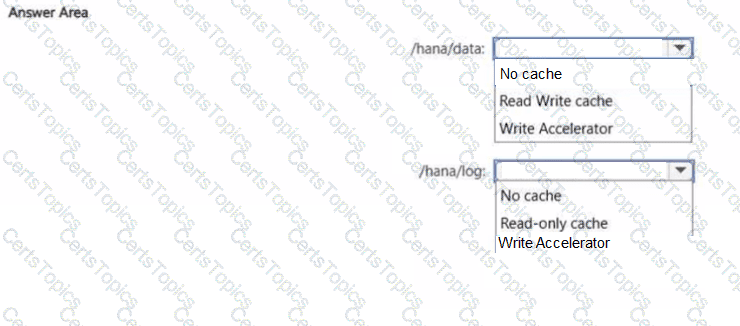
You deploy SAP HANA by using SAP HANA on Azure (Large Instances).
For each of the following statements, select Yes if the statement is true. Otherwise, select No.
NOTE: Each correct selection is worth one point.
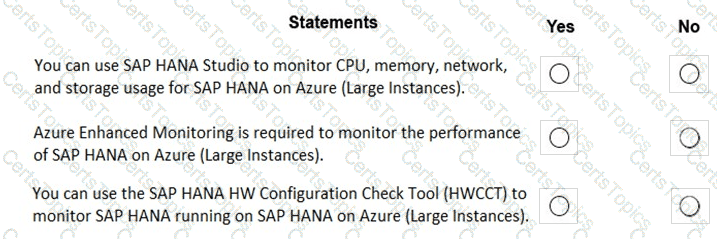
You have an Azure subscription that contains multiple virtual machines. The virtual machines host an SAP non-production landscape on Azure. You need to configure the virtual machines to stop and start at specific times. The solution must minimize administrative effort. What should you use?
You have an Azure subscription that contains two deployments of SAP NetWeaver on Azure named Production and Development. The Development deployment is used only during business hours and will be decommissioned after three months.
You need to recommend an optimization solution for the deployments. The solution must meet the following requirements:
• Maximize uptime of the Production deployment.
• Minimize costs, whenever possible.
What should you include in the recommendation for each deployment? To answer, select the appropriate options in the answer area.
NOTE: Each correct selection is worth one point.
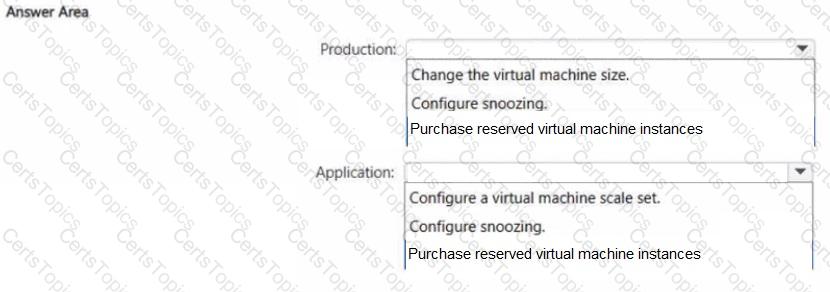
You have a highly available deployment of SAP NetWeaver on Azure virtual machines. The database tier is hosted on two virtual machines that run Windows Server 2019 and have Microsoft SQL Server 2017 installed. The NetWeaver, application, and database tiers each reside on a separate subnet within the same virtual network.
You run ABAPMeter against the deployment and discover that the average value of Act DB is 2 ms.
You need to lower the Acc DB value.
What should you do?
Your company has an SAP environment that contains the following components:
SAP systems based on SAP HANA and SAP Adaptive Server Enterprise (SAP ASE) that run on SUSE
Linux Enterprise Server 12 (SLES 12)
Multiple SAP applications
The company plans to migrate all the applications to Azure.
You need to get a comprehensive list of all the applications that are part of the SAP environment.
What should you use?
You are deploying SAP on Azure. The database server will use SAP HANA. The application servers will run Windows Server. You need to test network latency and throughput between the frontend SAP servers and the database servers. Which three tools can you use to achieve the goal? Each correct answer presents a complete solution.
NOTE: Each correct selection is worth one point.
You have an SAP HANA on Azure (Large Instances) deployment that has two Type II SKU nodes. Each node is provisioned in a separate Azure region. You need to monitor storage replication for the deployment. What should you use?
You have an instance of SAP NANA on Azure (Large Instances) named HIM.
You plan to deploy Azure virtual machines. The virtual machines will host application servers that will access the database on HLI1.
You need to minimize latency between the application servers and HLH
What should you do? To answer, select the appropriate options m the answer area
NOTE: Each correct selection is worth one point.


You have an SAP production landscape in Azure. The landscape is hosted on 50 virtual machines that run SUSE Enterprise Linux (SLES). The virtual machines are billed by using pay-as-you-go rates.
You need to minimize operating system costs for the virtual machines. What should you use?
You plan to automate a deployment of SAP NetWeave on Azure virtual machines by using Azure Resource Manager templates. The database tier will consist of two instances of an Azure Marketplace Microsoft SQL Server 2017 virtual machine image that each has 8 TB of RAM.
Which task should you include in the templates used to deploy the SQL Server virtual machines?
You have an SAP ERP Central Component (SAP ECQ) environment on Azure.
You need to add an additional SAP application server to meet the following requirements:
• Provide the highest availability.
• Provide the fastest speed between the new server and the database.
What should you do?
You have an Azure subscription that contains a virtual machine named VM1. VM1 runs SUSE Linux Enterprise Server (SLES) and hosts an SAP workload.
You deploy Azure Monitor for SAP solutions.
You need to configure the Linux OS provider. The solution must ensure that you can collect monitoring data by using the Prometheus endpoint on VM1.
Which firewall port should you open on VM1?
This question requires that you evaluate the underlined BOLD text to determine if it is correct.
You are planning for the administration of resources in Azure.
To meet the technical requirements, you must first implement Active Directory Federation Services (AD FS).
Instructions: Review the underlined text. If it makes the statement correct, select “No change is needed”. If the statement is incorrect, select the answer choice that makes the statement correct.
You need to provide the Azure administrator with the values to complete the Azure Resource Manager template.
Which values should you provide for diskCount, StorageAccountType, and domainName? To answer, select the appropriate options in the answer area.
NOTE: Each correct selection is worth one point.
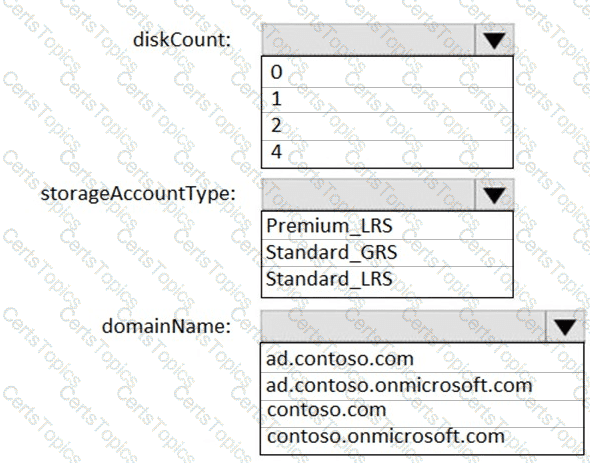
You are planning replication of the SAP HANA database for the disaster recovery environment in Azure.
For each of the following statements, select Yes if the statement is true. Otherwise, select No.
NOTE: Each correct selection is worth one point.
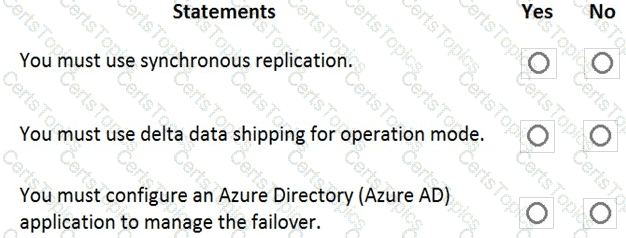
You are planning the Azure network infrastructure to support the disaster recovery requirements.
What is the minimum number of virtual networks required for the SAP deployed?
You are evaluating the proposed backup policy.
For each of the following statements, select Yes if the statement is true. otherwise, select No.
NOTE: Each correct selection is worth one point.
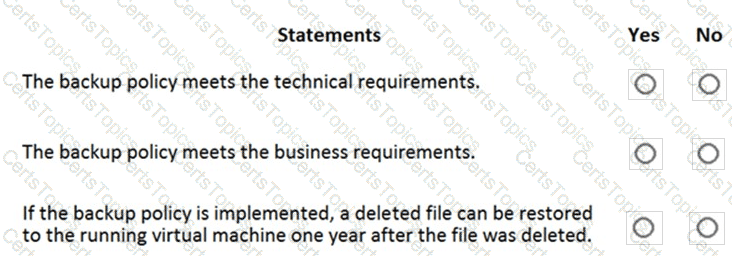
Once the migrate completes, to which size should you set the ExpressRoute circuit to the New York office to meet the business goals and technical requirements?
Which Azure service should you deploy for the approval process to meet the technical requirements?
Before putting the SAP environment on Azure into production, which command should you run to ensure that the virtual machine disks meet the business requirements? To answer, select the appropriate options in the answer area.
NOTE: Each correct selection is worth one point.

What should you use to perform load testing as part of the migration plan?
You need to recommend a solution to reduce the cost of the SAP non-production landscapes after the migration.
What should you include in the recommendation?
You need to ensure that you can receive technical support to meet the technical requirements.
What should you deploy to Azure?
For each of the following statements, select Yes if the statement is true. Otherwise, select No.
NOTE: Each correct selection is worth one point.

Litware is evaluating whether to add high availability after the migration?
What should you recommend to meet the technical requirements?
For each of the following statements, select Yes if the statement is true. Otherwise, select No.
NOTE: Each correct selection is worth one point.

You are evaluating which migration method Litware can implement based on the current environment and the business goals.
Which migration method will cause the least amount of downtime?
You are evaluating the migration plan.
Licensing for which SAP product can be affected by changing the size of the virtual machines?